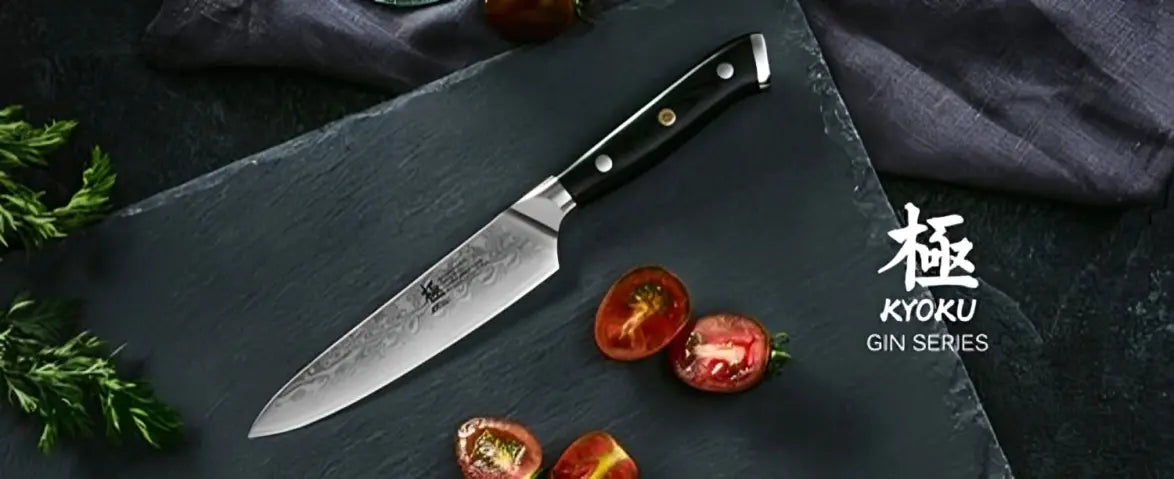If you've ever handled a high-end Japanese knife, you've likely encountered both G10 and micarta handles. While both materials have earned their place in professional kitchens, their subtle differences can significantly impact your cutting experience. You probably wonder how these materials perform when you're breaking down fish for sashimi, or pushing through hours of vegetable prep. While both G10 and micarta are composite materials (synthetic resin combined with either fiberglass or fabric), their subtle differences can significantly impact your cutting experience.
1. What is G10 Material and How is it Used in Knife Handles?

G10 consists of layers of fiberglass cloth soaked in epoxy resin, compressed and heated until incredibly hard. This process creates a material scoring 110 on the Rockwell M scale – comparable to some metals.
Micarta, by contrast, uses natural fibers like linen or canvas instead of fiberglass, achieving a slightly lower but still impressive 105 on the same scale.

This small difference in hardness creates distinct performance characteristics. G10's denser structure makes it virtually impermeable to water and oils, while micarta's natural fibers can absorb trace amounts of moisture over time. Despite being lighter than traditional handle materials, G10 maintains exceptional rigidity, crucial for precise knife control in professional kitchens.
2. G10 vs Micarta Performance in Kitchen Use
Where these materials truly diverge is in their grip characteristics. During extensive testing in professional kitchens, we've found that G10 handles maintain consistent grip even when wet, though they can feel slightly slick when new. Over time, G10 develops a subtle matte finish where your fingers contact the handle, enhancing grip without compromising its impermeable nature.
Micarta handles tell a different story. Their natural fibers create a slightly more tactile surface from the start, and this grip tends to improve as the handle develops what chefs call a "working patina." During fish butchery or vegetable prep, micarta offers excellent control in dry conditions but can become slightly less predictable when repeatedly exposed to oils and moisture.
G10's Grip Advantage in Japanese Knives

When executing the pull-cutting motion common in Japanese cuisine, a consistently reliable grip becomes essential. G10 handles excel here in several ways.
Initially, the handle might feel somewhat firm, but this characteristic proves advantageous during techniques like usuzukuri (thin slicing) or katsuramuki (rotary cutting), where precise control matters more than cushioned comfort.
In professional kitchens, grip reliability changes throughout a shift. Your hands might be dry while starting prep work, become wet while washing vegetables, then oily while breaking down fish, and sweaty during service hours. G10 handles demonstrate remarkable consistency across these conditions. G10 material's surface texture maintains its grip characteristics regardless of these changing conditions. This consistency proves invaluable when switching between different cutting techniques without needing to adjust your grip.
3. Micarta vs G10 Material Properties: Durability and Safety
In commercial kitchen environments, both materials excel in durability, but their differences become more pronounced. G10's superior chemical resistance means it withstands harsh sanitizing solutions without degradation. Its temperature stability (rated for continuous use up to 130°C/266°F) ensures consistent performance whether you're working the hot line or in cold prep.
Micarta also performs admirably but requires more attention in wet environments. While both materials are FDA-approved for food contact, G10's non-porous surface makes it particularly suitable for high-volume professional kitchens where bacterial resistance is crucial. Micarta's slight porosity means it requires more thorough drying between uses, especially in humid environments.
4. Comparing Micarta and G10 Maintenance Requirements
Daily maintenance reveals practical differences between these materials. G10 handles require minimal care – a quick wipe with your standard sanitizing solution is sufficient. Watch for any developing shine on the grip area, though this usually improves rather than hinders performance.
Micarta demands slightly more attention. Clean it immediately after exposure to oils or acidic ingredients, and ensure thorough drying to prevent moisture absorption. While both materials resist impact damage admirably, micarta can show early signs of wear through slight color changes in high-stress areas – though this rarely affects performance.
5. Best Kyoku Knives with G10 Handles

The proven benefits of G10 handles come to life in Kyoku's professional-grade Japanese knives. Let's explore how this material enhances specific knife styles for different cutting tasks.
Best Professional Chef's Knife with G10 Handle
The Kyoku Damascus Series 8-inch Chef's Knife brings out G10's full potential for all-purpose kitchen work. Its G10 handle maintains consistent grip through hours of prep work while perfectly balancing the VG10 steel blade.
Highlighted specs:
✓ Blade length: 8 inches
✓ Handle material: G10 Fiberglass
✓ Best for: Professional kitchen prep
✓ Blade steel: Damascus steel
✓ Edge angle: 15 degrees per side
✓ Weight: 23 oz
✓ Warranty: Lifetime
Perfect for: Professional chefs and serious home cooks who need a reliable workhorse for extended prep sessions.
Best Precision Cutting Knife with G10 Handle

The Kyoku Gin Series 7-inch Santoku excels in precise vegetable and protein preparation. Its G10 handle provides exceptional control during detailed cutting tasks while resisting kitchen oils and sanitizing solutions.
Highlighted specs:
✓ Blade length: 7 inches
✓ Handle material: G10 fiberglass
✓ Best for: Precise vegetable and protein prep
✓ Blade steel: VG10 Stainless steel
✓ Edge angle: 8-12 degrees
✓ Weight: 9 oz
✓ Warranty: Lifetime
Perfect for: Cooks who prioritize precision cutting and need reliable performance in wet conditions.
You can also explore more on the Kyoku website to discover a full range of professional Japanese knives with G10 handles.
6. Choosing Between G10 and Micarta
Your choice between G10 and micarta should ultimately depend on your specific needs. For high-volume professional kitchens with strict sanitation requirements, G10's impermeability and chemical resistance make it an excellent choice. For those who prefer a handle that develops a personalized feel over time, micarta's natural fiber composition offers a unique working experience. Either way, both materials represent a significant upgrade over basic synthetic handles and will serve well in demanding kitchen environments.

















